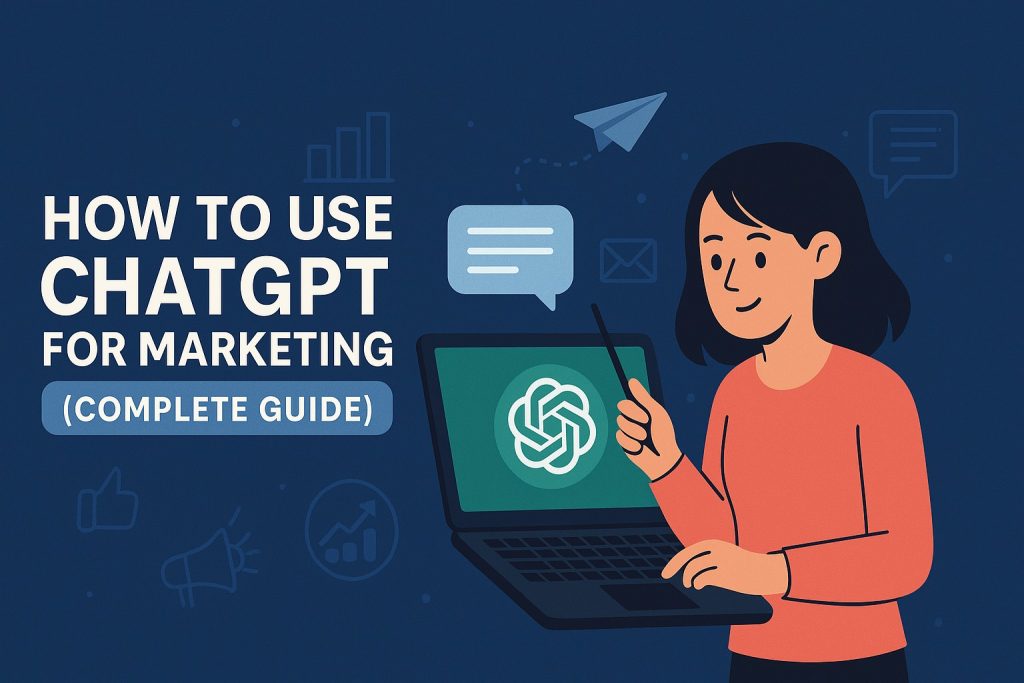The marketing world is transforming faster than ever before and need to learn Use ChatGPT for Marketing and other AI tools besides. Artificial intelligence has shifted from being a luxury tool to an everyday necessity, and ChatGPT stands at the center of this transformation. For new marketers, ChatGPT can act as a personal assistant, strategist, content creator, and data analyst all at once. Whether you’re trying to create engaging blog content, plan an email marketing strategies campaign, or write on-site SEO-optimized content and product descriptions, ChatGPT can make every process faster and smarter. But success doesn’t depend on simply using AI it depends on how strategically you use it.

This image also perfectly generate by ChatGPT 5 (Check the prompt below)
Create a high-quality 2:1 feature image for a blog post titled “How to Use ChatGPT for Marketing (Complete Guide)”.
The scene should show a modern digital marketer sitting at a desk or standing confidently, using a laptop with the ChatGPT logo on the screen. Around the person, include subtle floating marketing icons such as email, SEO graph, megaphone, analytics, and social media bubbles.
The design should have ample empty space on the left and right sides for text placement and visual breathing room.
Use a professional, clean color palette — sky blue, white, light green, and navy tones — matching a marketing or AI-tech theme.
The title text “How to Use ChatGPT for Marketing (Complete Guide)” should appear in bold, readable typography, aligned either left or center.
Style: flat vector illustration, minimal, modern, and brand-friendly — suitable for a professional blog like avenuesangma.com.
I am sharing something very exclusive insights and we’ll explore practical ways new marketers can use ChatGPT to improve efficiency, boost creativity, and achieve measurable marketing results.
What Is ChatGPT and Why It Matters in Marketing
Understanding ChatGPT’s role in marketing begins with recognizing how it replicates human communication. ChatGPT is an AI model built on deep-learning architecture that interprets text inputs and produces responses that sound natural and professional. For marketers, this means having a reliable digital copywriter and researcher available 24/7. ChatGPT matters because it doesn’t just create text, it creates context. It helps marketers analyze audiences, craft personalized content, and build consistent brand messaging. As marketing moves toward automation and personalization, ChatGPT allows even small teams to compete at scale, offering the kind of quality and speed that used to be reserved for large agencies.
Why Marketers Are Turning to ChatGPT
- Efficiency: Reduces the time required to write blogs, social posts, and ads.
- Scalability: Produces high volumes of content without sacrificing quality.
- Personalization: Helps segment audiences and tailor messages.
- Cost Reduction: Minimizes outsourcing and creative overhead.
- Creativity Boost: Generates fresh ideas and unique campaign concepts.
How to Start Using ChatGPT as a New Marketer
Before diving into tools or templates, beginners must start with clarity. ChatGPT can only perform effectively when you feed it with the right intent. The deeper your understanding of your brand goals, audience type, and communication tone, the more accurate its outputs become. Think of it as a conversation with a human assistant you must give clear instructions. Learning how to write prompts and structure requests is the foundation of successful AI-assisted marketing.
1. Define Your Marketing Goals
Start by setting measurable objectives such as generating leads, improving engagement, or boosting organic traffic. ChatGPT can craft strategies aligned with each goal—from awareness to conversion
Before typing a single prompt, know what you want ChatGPT to achieve:
- Do you want more website traffic?
- Are you creating brand awareness?
- Are you generating leads or improving conversions?
When you’re clear on the goal, ChatGPT can generate content aligned with your marketing funnel awareness, consideration, or decision..
2. Learn to Write Effective Prompts
Good prompts are specific, detailed, and action-oriented.
Formula: Role + Task + Context + Output Format + Tone.
Example: “Act as a senior digital marketer and write a 200-word Facebook ad for eco-friendly tiles in a persuasive tone.”
Example of a weak prompt:
“Write a post about digital marketing.”
Example of a strong prompt:
“Write a 200-word LinkedIn post explaining why digital marketing is crucial for small businesses in 2025, with a motivational tone and a CTA at the end.”
Strong Long Tail prompt for Blog Post
“Write a 2,500-word, 100% plagiarism-free and SEO-optimized blog post titled “Why Digital Marketing Is Crucial for Small Businesses in 2025.” Use a motivational, forward-looking tone that inspires entrepreneurs and small business owners to embrace digital transformation. Begin with a compelling introduction that sets the stage for how marketing has evolved by 2025. Explain key reasons digital marketing is vital — including visibility, affordability, customer engagement, data-driven growth, and competitiveness in the modern landscape. Use clear H2 and H3 headings, examples, bullet points, and storytelling to make it relatable. Include references to modern tools like AI, automation, and personalization. Emphasize challenges, opportunities, and future trends. End with a motivational call to action urging readers to start implementing digital marketing strategies today to future-proof their business success. Optimize the content for the keyword “digital marketing for small businesses in 2025.”
ChatGPT for Content Marketing
Content is the lifeblood of marketing, and ChatGPT can turn ideas into words faster than any human team. From long-form blogs to micro-posts, it ensures your brand voice stays consistent. More importantly, ChatGPT supports research, outlines, SEO optimization, and tone alignment. This makes it perfect for new marketers struggling to balance creativity with structure.
1. Blog Writing and SEO
ChatGPT helps you go from topic research to polished publication. Begin with idea generation (“Suggest 10 blog titles about sustainable marketing”) and then build an outline. Once you approve the structure, have ChatGPT write the introduction, add sub-headings, and integrate SEO keywords naturally. You can also ask it to write meta titles, descriptions, and FAQs to improve ranking potential. Pairing ChatGPT with tools like Ahrefs or Google Keyword Planner ensures your blogs are both creative and data-driven.
Workflow:
- Outline creation: “Create a detailed outline for a 1500-word blog on ‘How to Build an Email List’ with H2s and H3s.”
- Topic research: “Suggest 10 SEO-optimized blog titles for the keyword ‘email marketing for beginners’.”
- Draft writing: “Write an introduction in a conversational tone for this blog post.”
- Optimization: “Add SEO keywords naturally to improve ranking for ‘email marketing tips’.”
Pro Tip: Combine ChatGPT with tools like Surfer SEO, Ahrefs, or Google Keyword Planner for data-driven keyword accuracy.
2. Social Media Content
Social platforms demand constant creativity. ChatGPT can help you plan, write, and schedule posts across channels. For instance, you can prompt: “Create a 30-day content calendar for LinkedIn posts about digital marketing tips.” It can also tailor captions for Instagram, generate hashtags, or rewrite posts for different tones—formal, humorous, or conversational. Repurpose your long blogs into short, shareable posts, ensuring content consistency across all touchpoints.
Example prompts:
- “Write 5 Instagram captions promoting eco-friendly ceramic products with emojis.”
- “Create a one-month LinkedIn content calendar for a marketing consultant.”
- “Generate tweet threads about AI tools for marketers.”
Benefits:
- Maintain your brand tone.
- Save time on daily posting.
- Repurpose long-form content into short posts.
3. Email Marketing
Emails still deliver one of the highest ROIs in digital marketing. ChatGPT assists by writing welcome emails, newsletters, drip campaigns, and re-engagement sequences. You can instruct it to include urgency (“limited offer”), personalization (“Hi [Name]”), or curiosity (“Guess what’s new this week?”). It can even generate A/B variations of subject lines to test performance.
Prompt ideas:
- “Write a welcome email for new subscribers of a ceramic brand newsletter.”
- “Generate 3 A/B test subject lines for a holiday sale campaign.”
- “Create a re-engagement email for inactive users.”
Pro Tips: Ask ChatGPT to include emotional triggers like urgency (“limited time”), curiosity (“you won’t believe what’s new”), or personalization (“just for you”).
4. Copywriting for Ads
ChatGPT can generate powerful ad copy that attracts clicks. For example, ask: “Write three Facebook ad variations promoting luxury ceramic tiles for Charu Ceramic.” It can deliver persuasive headlines, emotional triggers, and clear CTAs. Use it to test different tones—emotional, informative, or luxury—to find what resonates best with your audience.
Example prompts:
- “Write 3 variations of a Facebook ad promoting a luxury bathroom collection for Charu Ceramic.”
- “Create Google ad headlines within 30 characters for the keyword ‘best sanitaryware in Bangladesh’.”
- “Write an ad script for a 15-second YouTube pre-roll ad about sustainable tiles.”
ChatGPT helps you:
- Craft emotional hooks.
- Test multiple CTAs.
- Keep your message consistent across campaigns.
ChatGPT for Market Research
Research is the backbone of strategy, and ChatGPT accelerates the process by summarizing large amounts of information and identifying key insights. It can describe buyer personas, analyze competitors, and forecast trends—all essential for a data-driven marketing plan.
1. Audience Analysis
ChatGPT can create detailed buyer personas when you provide demographic and psychographic data. For instance: “Describe a 35-year-old professional woman in Dhaka interested in sustainable interior design.” It will return insights into her motivations, purchase behavior, and preferred platforms—helping you personalize content effectively.
Prompt example:
“Create a detailed buyer persona for a 30-year-old urban woman in Bangladesh interested in eco-friendly home décor.”
You’ll get demographic, psychographic, and behavioral insights that help you craft targeted campaigns.
2. Competitor Analysis
Use ChatGPT to generate SWOT comparisons between your brand and competitors. Example: “Compare Charu Ceramic and RAK Ceramics in Bangladesh based on strengths, weaknesses, opportunities, and threats.” This helps identify positioning gaps and new market opportunities.
Prompt example:
“List the strengths, weaknesses, opportunities, and threats (SWOT) of RAK Ceramics vs Charu Ceramic in Bangladesh.”
This helps you identify differentiation points for your marketing positioning.
3. Trend Forecasting
AI can recognize patterns and summarize emerging trends from 2024 and beyond. Request: “List the top digital marketing trends for 2026 relevant to B2B manufacturing.” ChatGPT will outline innovations such as AI personalization, voice search, and sustainability marketing.
Prompt example:
“Summarize the top marketing trends for 2025 in the building materials industry.”
While ChatGPT can’t access proprietary data, it can synthesize known insights and generate smart predictions for planning.
ChatGPT for SEO and Website Marketing
SEO remains one of the most technical and crucial parts of marketing. ChatGPT simplifies it by assisting in keyword ideation, content optimization, and structure creation. When used strategically, it helps you write SEO-friendly titles, descriptions, and internal links without keyword stuffing.
1. Keyword Research Support
ChatGPT is excellent for brainstorming seed keywords or semantic variations. Example: “Generate 20 long-tail keywords related to ‘modern bathroom fittings United States (USA).’” Verify these in Google Keyword Planner to ensure real search volume.
Prompt example:
“Generate 20 long-tail keywords related to ‘bathroom fittings Bangladesh’.”
Then, validate those keywords using an SEO tool like Google Keyword Planner, Ubersuggest, or SEMrush.
2. On-Page SEO Assistance
Ask ChatGPT to improve readability, write meta tags, and structure H1-H3 headings logically. You can prompt: “Write a 160-character meta description for a blog titled ‘Best Sanitaryware Brands in Canada’” It also helps create anchor text variations for internal linking strategies.
ChatGPT can help you:
- Write SEO titles and meta descriptions.
- Optimize H1-H3 structures.
- Suggest internal linking ideas.
Example:
“Write a 160-character meta description for a blog titled ‘Top Business Ideas in Bangladesh’.”
Pro Tips:Use it to create semantic anchor variations (e.g., “business ideas in Canada,” “small business opportunities in Canada,” “profitable ventures in Canada”) for natural internal linking.
3. Content Repurposing
Maximize every piece of content. Turn one blog into a newsletter, short LinkedIn post, or infographic. Prompt: “Summarize this 1000-word article into five short tweets with strong hooks.” This multiplies reach across channels while maintaining SEO consistency.
You can turn one blog post into multiple content pieces:
- Convert it into a video script.
- Extract quotes for social media.
- Summarize it into an infographic or newsletter.
Prompt example:
“Summarize this 1000-word blog into 5 short LinkedIn posts with unique hooks.”
ChatGPT for Branding and Storytelling
Brand storytelling is where AI meets emotion. While ChatGPT cannot feel, it understands narrative structure and can replicate storytelling frameworks that resonate with audiences. For new marketers, this is a game-changer—allowing consistent messaging across digital and offline media.
1. Brand Voice Creation
Prompt ChatGPT to define your tone: “Create a brand voice guideline for a premium home-improvement brand, tone should be confident, elegant, and innovative.” It will deliver examples of phrases, adjectives, and emotional cues to guide your future messaging.
Prompt example:
“Create a brand voice guideline for a premium sanitaryware company tone should be elegant, trustworthy, and innovative.”
You’ll get tone descriptions, example sentences, and vocabulary to ensure consistency across your marketing channels.
2. Mission and Vision Statements
If you’re building a new brand, ChatGPT can articulate your mission and vision based on your values. Example: “Write a mission statement for a ceramic brand focused on eco-friendly innovation.”
Prompt example:
“Write a mission and vision statement for a sustainable home improvement brand in USA.”
3. Brand Storytelling
Storytelling makes customers connect emotionally. You can instruct ChatGPT: “Write a brand story using the Hero’s Journey format for Eagle Ceramics, focusing on innovation and sustainability.” This creates a narrative your audience remembers.
Prompt example:
“Write a brand story using the Before-After-Bridge framework for Eagle Ceramics to highlight innovation in water-saving technology.”
Prompt example:
“Write a brand story using the Before-After-Bridge framework for Charu Ceramic to highlight innovation in water-saving technology.”
Best Practices for New Marketers
- Always fact-check outputs.
ChatGPT can occasionally generate outdated or generalized information. Verify statistics and claims. - Refine your prompts iteratively.
Start broad, then refine until the tone and context fit your goal. - Use ChatGPT as an assistant, not a replacement.
Human creativity and emotional understanding still win hearts. - Combine with data tools.
Use ChatGPT insights with analytics platforms like Google Analytics, HubSpot, or Power BI. - Maintain brand consistency.
Save your tone of voice and brand guidelines so ChatGPT follows the same style every time.
Ethical Use of ChatGPT in Marketing
AI should support authenticity, not replace it. Always disclose AI assistance where appropriate and ensure content aligns with your brand’s truth and customer trust.
Do’s:
- Use it for ideation, drafts, and summaries.
- Edit outputs to add your voice and facts.
Don’ts:
- Copy content without verification.
- Generate fake reviews or misleading ads.
Transparency builds long-term brand credibility.
Future of AI and Marketing
By 2030, over 70% of marketing interactions are expected to involve AI-powered tools. ChatGPT will evolve to provide real-time data analysis, image generation, and campaign automation.
Marketers who master AI tools now will lead the next decade of brand innovation—where human creativity meets machine intelligence.
Key Takeaways
- ChatGPT helps new marketers accelerate content creation, planning, and analysis.
- Learn to craft precise prompts to get the most accurate results.
- Use it for SEO, content marketing, PPC, branding, and research.
- Always verify data and personalize outputs.
- Combine AI insights with real-world creativity for the best results.
Final Thoughts
ChatGPT isn’t just a writing tool it’s a strategic partner for modern marketing. Whether you’re building brand awareness, writing ad copy, or optimizing for SEO, it can cut hours of manual work while boosting creative impact.
For new marketers, mastering ChatGPT means unlocking speed, efficiency, and innovation. When used wisely—with human judgment and creativity—it can help you craft campaigns that connect, convert, and create real value in the digital age.


